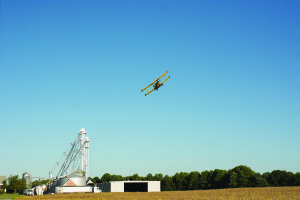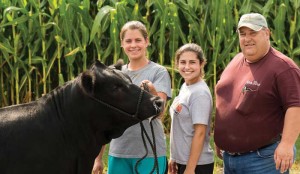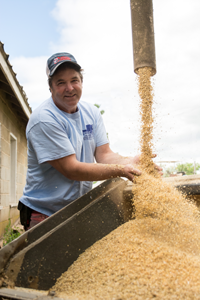Maryland Farmers Are Breaking Records
Cover Crop Program Sees Best Participation Yet
 (ANNAPOLIS, MARYLAND) – A small airplane swoops low over a field of golden soybeans, and then zooms back up into the air before making another round at Schmidt Farms, located on the Eastern Shore of Maryland.
(ANNAPOLIS, MARYLAND) – A small airplane swoops low over a field of golden soybeans, and then zooms back up into the air before making another round at Schmidt Farms, located on the Eastern Shore of Maryland.
“What we’re doing is an aerial application of cover crops,” explains Hans Schmidt, on a sunny day last fall. “Applying the cover crop seeds while the original crop is still in the field allows us to take advantage of seed mixes that produce dual results for soil health.”
Schmidt Farms is one of many Maryland farms which together seeded a record 492,244 acres of cover crops last fall, the Maryland Department of Agriculture has announced. Maryland farmers have exceeded the Watershed Implementation Plan milestone goals in 2011, 2013 and 2015 for cover crops and are on track to exceed the next two year milestone in 2017 with this new record enrollment acreage.
Cover crops are widely recognized as one of the most cost-effective and environmentally sustainable ways for farmers to meet nutrient and sediment reduction targets outlined in Maryland’s Watershed Implementation Plan to protect and restore the Chesapeake Bay by 2025.
“Maryland farmers believe in the environmental and agronomic benefits of planting cover crops on their fields to improve the soil, recycle unused plant nutrients, control erosion, and protect local waterways,” said Maryland Secretary of Agriculture Joe Bartenfelder. “This is the sixth consecutive year that farmers have planted more than 400,000 acres of cover crops on their fields.”
Schmidt Farms is a third generation family farm, operated by Hans and his wife, Jennie, and Hans’ brother, Alan and his wife Brenda. The farm cultivates about 2,000 acres of food and feed – high oleic soybeans used to create soybean oil, soybeans used in tofu and soy milk, green beans, tomatoes and wine grapes. In addition, they grow soy, corn and barley for animal feed.
Using a cover crop application program allows the farm to feed nutrients into the top soil, and at the same time improve the fields’ soil tilth.
“Tilth is the physical condition of the soil that allows for a healthy root system to support plant growth and plant health,” says Jennie. “Having soil with good tilth means that the soil has large pore spaces for oxygenation and water filtration. This all adds up to a better no-till program in the spring and a reduced use of fertilizer.”
The cover crop program is not a new idea on the farm. In fact, Walter Schmidt was one of the first farmers in the country to implement cover crops, way back in the late 1960s.
“Dad wanted to ensure that the next generation of our family had healthy soils to continue our family farming legacy,” says Hans. “He certainly was able to meet that goal, and Alan and I continue the practice of constantly improving our soils.”
The Schmidt family goes out of its way to promote environmental stewardship and leadership for agriculture in Maryland. The farm has earned a designation of Certified Agricultural Conservation Steward under the Farm Stewardship Certification and Assessment Program (FSCAP), and Hans, who recently “retired” as volunteer chairman of the Maryland Soybean Board and from the Maryland Association of Soil Conservation Districts, has been appointed Assistant Secretary of Resource Conservation at the Maryland Department of Agriculture. Jennie is now president of the Maryland Grain Producers Utilization Board.
“It’s rewarding to grow food for our neighbors, and the larger community,” says Hans. “We all have an influence on the environment. As farmers, we put the safety and health of the environment first. We are not the only farmers doing this, for most, it’s second nature.”
The Maryland Soybean Board and United Soybean Board are funded by the national soybean checkoff. Through the checkoff program, farmers contribute one-half of one percent of the net market value of soybeans at the first point of sale. These funds are used for research, marketing and education projects. To learn more, visit www.www.mdsoy.com.
This Thanksgiving Season Be Thankful for Maryland’s Family Farms
November 25, 2015 – Thanksgiving is a time for food, family and fellowship. For Maryland family farmers, it’s also a time to be thankful that the year’s crops have been harvested and that their animals have had another year of superior care.
Recently completed USDA census data has found that that 97 percent of farms in the U.S. are family-owned businesses. These farms are very diverse, but remain the core of the U.S. agriculture industry.
On Pleasant Valley Farm, family is the centerpiece of the farming operation. Located in Brookville, Md., the farm is run by two father-son partners: Robert and Randy Stabler and Breck and JB Debnam. Randy’s daughters, Kelsey Thomas and Shelby Stabler, are also involved in the day-to-day operations.
“Our families have a passion for agriculture,” says Randy Stabler. “We love what we do and take pride in producing high-quality food for our neighbors.”
Pleasant Valley Farm grows soybeans and corn on 2,500 acres, as well as selling natural, grain-fed Black Angus beef and fresh sweet corn at their farm stand.
“One of the reasons we love farming is the opportunity to work with our families,” says JB Debnam. “After working off the farm for 12 years, I came back to work with my dad and Randy’s family, and it was one of the best decisions of my life.”
 Pleasant Valley Farm was originally started by Robert Stabler and his brother, Drew in 1954. In 1987, Randy came into the partnership; and in 2001, Drew withdrew. Fast forward to 2011, and the Debnams joined the partnership; merging the two farm families together.
Pleasant Valley Farm was originally started by Robert Stabler and his brother, Drew in 1954. In 1987, Randy came into the partnership; and in 2001, Drew withdrew. Fast forward to 2011, and the Debnams joined the partnership; merging the two farm families together.
“Together, we’ve been able to build a farm that is sustainable and will be an opportunity for the next generation,” says Randy. “We can sustain both families, and each of us has the ability to realize our dreams.”
To learn more about soybeans and how they are used on Maryland farms, visit www.www.mdsoy.com.
The Maryland Soybean Board administers soybean checkoff funds for soybean research, marketing and education programs in the state. One-half of the checkoff funds stay in Maryland for programs; the other half is sent to the United Soybean Board. To learn more about the Maryland Soybean Board, visit www.www.mdsoy.com.
Know Your SCN Numbers
Click here to download the latest information on SCN and find out how to have your soil tested.
Ice Cream is Part of This Farm’s Story
SALISBURY, MD. (July 19, 2015) –Ice cream may be ubiquitous to summer, but for one dairy farmer in Tuscarora, Md., this sweet treat is much more, it’s part of his family’s story. In 2009, Chuck Fry, and his wife, Paula, were looking for a way to diversify the income from their dairy farm.
“I’ve always taken a milk stool approach,” says Fry. “Our business, like a milk stool, should have three legs. For us, two of those legs are the cows and the crops. We were looking for a third leg to complete our family business.”
It was Paula who convinced Chuck to consider making and selling ice cream on their farm. Centrally located off a main highway to Frederick, Md. and Leesburg, Va., Rocky Point Creamery would be able to serve two large metro populations.
Several years of research and planning followed, and in 2011, the Fry’s broke ground on the Creamery building, situated at the entrance to their dairy farm. The family started serving their homemade ice cream soon after, and now, there is a steady stream of customers.
“We knew our customers would come from Frederick and Leesburg, but actually, we have many customers from Washington, D.C. For them, it’s a destination, a chance to experience a real, live dairy farm,” says Fry.
While customers may see the farm as a destination, to Chuck, a fourth generation farmer, the farm is his family’s lifestyle and livelihood.
“Our cows are our number one priority,” says Fry. “From the high-quality feed they eat, to the superior veterinarian and herdsman care, to the clean and open housing, each cow is treated with respect.”
One of the feeds that the cows at Rocky Point Farm turn into delicious ice cream is fresh ground and roasted soybeans.
“Maryland dairy farmers feed more than 9,000 tons of soybean meal each year,” says Fry. “On our farm, we grow, harvest, roast and grind the soybeans ourselves. On demand roasting and grinding helps retain the good oil in the soybeans. Combined with other quality feeds, our cows eat to produce premium milk.”
That milk is turned into the ice cream that Rocky Point Creamery customers enjoy.
“Ice cream fresh from our farm,” says Fry. “That’s our motto, and our promise to our customers. Being able to share a little slice of our family farm with our customers is wonderful.”
Maryland farmers grow about a half a million acres of soybeans every year, harvesting between 16 to 20 million bushels that are used to feed poultry and livestock.
According to the United Soybean Board, animal agriculture in Maryland represents $2.4 billion in economic output, $394 million in household income, and 14,300 jobs.
In addition, it yielded an estimated $99 million in income taxes and $48 million in property taxes.
To learn more about Rocky Point Creamery, visit www.rockypointcreamery.com.
Archives
No Results Found
The page you requested could not be found. Try refining your search, or use the navigation above to locate the post.
